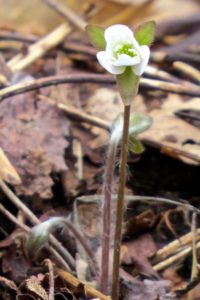Back in January I surveyed the Tellico Fire with MountainTrue biologist Josh Kelly. We were there to check out the intensity and severity of the fire. The date was January 19 and we found a few Hepatica acutiloba (sharp-lobed hepatica) in flower. Kelly said that was the earliest he had ever seen it in flower. Today, taxiing kids to and from school, I noticed a large maple in full flower around Exit 98 on US 23/74. And then, paying a bit more attention I saw redbuds in flower on my road. I know red maple and redbud are some of the earliest flowering plants to burst in the spring and I can’t say for sure if February 13 would be considered early – seems so to me. But, I’ve never seen hepatica in January and I trust Kelly’s assertion that January 19 is an early date for hepatica.
The early flowers reminded me of a Facebook post I recently saw from Quentin Ellison, editor of The Sylva Herald, regarding an ongoing phenology study in the Great Smoky Mountains National Park (GSMNP.) Phenology can be described as the study of cyclic and seasonal natural phenomena especially in relation to climate and flora and fauna. Some phenological events include the flowering of plants, leafing out of trees, migration, and hibernation.
The program in the GSMNP is headed up by the Great Smoky Mountains Institute at Tremont. According to Tremont’s website, they have been studying some aspects of phenology, like when the first bloodroot is found flowering or when the first Black-throated green warbler arrives in the spring for more than 30 years. But in 2010, due to concerns regarding climate change, Tremont decided to take a closer look at phenology in the Park. They partnered with the National Phenology Network and established eight plots to visit regularly during transitional (spring and fall) seasons. The Park expanded on this effort and established 30 more plots at different elevations, with different aspects (the direction the topography is facing i.e. south facing slopes vs. north facing slopes, etc.) and in different forest types.
The Appalachian Highlands Science Learning Center at Purchase Knob has been one of the entities working on the phenology study in the Park. Susan Sachs, education coordinator for the Learning Center, told Earth Island Journal, last July, “We want people to understand that we are experiencing climate change now, not some time in the future.”
She noted that the Park has been experiencing more and more intense temperature swings in the spring. Warm temperatures in early spring can influence trees to leaf out and bud earlier – then a cold snap in late spring kills the buds creating a scarcity of mast in the fall.
Like all good science projects this phenology study begins by creating more questions than it answers. In other words will warm early springs entice caterpillars and other insects to emerge earlier, and if so, will Neotropical migrants need to arrive earlier to take advantage of this food source that is critical for nesting success?
It will take years of data to reveal any concrete answers, which is one reason the Park Service is promoting several Citizen Science opportunities. The good thing about phenology studies is they are well suited for Citizen Science – the clues researchers are monitoring like leaf-out, budding time and arrival of migrants are pretty easy to observe and the Intergovernmental Panel on Climate Change has noted that phenology is perhaps, “…the simplest process in which to track changes in the ecology of species in response to climate change.”
Spring 2017 is already gearing up and the GSMNP is seeking volunteers to assist with these phenology studies. There will be training sessions at the Sugarlands Visitor Center on February 25 and at Oconaluftee Visitor Center on March 11.
To volunteer and/or learn more contact Natalie Rothenberg at Natalie_Rothenberg@partner.nps.gov or by phone at 828.497.1945.

